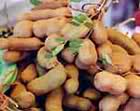 Tamarind (Tamarindus indica Linn.) is one of the minor fruit crops in the Philippines with a great potential for commercialization. In certain parts of the country, it is an important crop because its fruits and other parts have varied food and medicinal uses.
Tamarind (Tamarindus indica Linn.) is one of the minor fruit crops in the Philippines with a great potential for commercialization. In certain parts of the country, it is an important crop because its fruits and other parts have varied food and medicinal uses.
Tamarind has great export potential because its fruit may be processed into a number of acceptable products. But the mature and ripened tamarind fruit of the sweet type is said to be more important and expensive than when it is processed. However, the supply still does not meet the demand.
Sweet Tamarind Propagation
Tamarind may be propagated by seeds and asexual propagation (i.e. grafting). Propagation by seeds is not recommended because the resulting plants do not grow true-to-type.
Seeds obtained from healthy and mature fruits should be cleaned. Individual seeds are planted about two centimeters deep in potted soil rich in organic matter. A soil media with one part soil, one part sawdust, and one part compost is suggested.
For sweet tamarind, cleft grafting is recommended especially for large-scale propagation because it gives a higher percentage of success.
Rootstocks which are six months or older (about 0.8 to 1 cm in diameter) are used for grafting. Mature scions (budsticks) measuring 8-15 cm long and with the same diameter as rootstocks, and with well-developed buds are collected from full-bearing trees of outstanding characteristics. Defoliate the scion after collection and graft immediately. After grafting, cover the scion with plastic ice bag (4×12 in) and place the newly grafted plants under the shade. Transfer them in the open (full sunlight) when the new shoots develop.
Water the plants regularly. In 3-4 weeks, the scion will start to form shoots. It’s best to graft starting November up to May.
Transplanting
Before the onset of the rainy season, the land must be plowed once and harrowed several times until the soil is in its fine tilth. Stakes are set following the desired distance of planting (8 x 10 m). The dug holes must be large enough to accommodate the root system of the plants. The soil around the base of the plant should be packed firmly.
For lahar-laden areas, mix 5 kg compost with the soil. Put about six inches of the mixture before planting. Cover the base of the plant with the remaining mixture. Planting is best done during the rainy season.
Intercropping
For large-scale planting, intercrop the tamarind with short-season cash crops. This way, some income could be derived while the trees are not yet bearing fruits. When the trees have grown and their branches begin to touch each other, intercropping should be stopped.
Irrigation
Water the plants right after planting. This must be done as the needs arises. Sufficient water should be provided during the early years. In later years, watering becomes less critical. Irrigation is beneficial, especially for the development of flowers and fruits.
Fertilization
Tamarind trees bear fruit well even without fertilization. However, fertilizer application is recommended to keep the trees in healthy condition. As a general recommendation: apply 50 g of 16-20-0 and 100 g of 14-14-14 per tree one month after planting. The same amount is added at the end of the rainy season. The amount of fertilizer is gradually increased as the trees grow.
For early bearing fruits, apply 500 g of 14-14-14 per tree twice a year. A full bearing tree may need at least 3 kg of 14-14-14 per year.
Trimming and Pruning
Young trees require little trimming during the first few years. Remove the very low branches and cut long upright shoots during the early years. For bearing trees, remove dead, weak, diseased branches and water sprouts.
Control of Insect Pest and Diseases
There are no major diseases of sweet tamarind observed. However, insect pests such as bagworms, mealybugs, scale insects, leaf feeding caterpillars, shorthole borers and green locust were recorded. These pests may be controlled by spraying the trees with common insecticides at the recommended dosage.
Harvesting
Grafted sweet tamarind may start fruiting in about a year after planting. The fruit may be harvested half-ripe (malasebo) stage and full ripe stage.
To determine the half-ripe stage, scratch the fruit surface with the fingernail at the side not exposed to the sun to remove the brownish powdery material. Mature fruits have brown shells.
Fully ripened fruits are determined by just tapping with the finger which produces a hollow, loose sound. This is because the pulp shrinks at maturity and the skin becomes brittle. Since the fruits mature at different times, harvesting must be done by priming.
Fruits are usually harvested from January to February as the trees bear flowers in May or June.
(For more information contact the Pampanga Agricultural College, Magalang, Pampanga, or visit their website at http://www.pac.edu.ph)
Source: Filomena K. Reyes – bar.gov.ph, July-September 2000 Volume 2 No. 3



I want to learn about sweet tamarind farming in srilanca,